A Method for Validating the Structural Completeness of Understory Vegetation Models Captured with 3D Remote Sensing
Abstract
1. Introduction
2. Materials and Method
2.1. Validation Frame Design
2.2. Point Cloud Collection
2.3. Co-Registration of Validation Measurements and Point Clouds
2.4. Voxelisation
2.5. Metric Determination and Validation
2.6. Case Studies
2.6.1. Sensors
TLS Data Collection
Image Based Data Collection
2.6.2. Case Study 1: Effect of Frame on Point Cloud
Point Cloud Co-Registration
Analysis
2.6.3. Case Study 2: Validation
Site Descriptions
Plot Set-Out
Point Cloud Filtering
Point Cloud Normalisation
Data Analysis
3. Results
3.1. Case Study 1
3.2. Case Study 2
3.2.1. Correlation of Vegetation Structure
3.2.2. Accuracy of Ground Estimation
3.2.3. Normalised Correlation between Point Clouds and Reference Measurements
3.2.4. Validation of First Intercept Height
3.2.5. Validation of Vegetation Cover
4. Discussion
5. Conclusions
Author Contributions
Funding
Acknowledgments
Conflicts of Interest
Abbreviations
| SfM | Structure from Motion |
| TLS | Terrestrial Laser Scanning |
| RMSE | root mean squared error |
| MCC | Matthews correlation coefficient |
| TP | true positive |
| TN | true negative |
| FP | false positive |
| FN | false negative |
| TIN | triangulated irregular network |
| DTM | digital terrain model |
References
- Wallace, L.; Hillman, S.; Reinke, K.; Hally, B. Non-destructive estimation of above-ground surface and near-surface biomass using 3D terrestrial remote sensing techniques. Methods Ecol. Evol. 2017, 38, 42–49. [Google Scholar] [CrossRef]
- Calders, K.; Newnham, G.; Burt, A.; Murphy, S.; Raumonen, P.; Herold, M.; Culvenor, D.; Avitabile, V.; Disney, M.; Armston, J.; et al. Nondestructive estimates of above-ground biomass using terrestrial laser scanning. Methods Ecol. Evol. 2015, 6, 198–208. [Google Scholar] [CrossRef]
- Foody, G.M. Remote sensing of tropical forest environments: Towards the monitoring of environmental resources for sustainable development. Int. J. Remote Sens. 2003, 24, 4035–4046. [Google Scholar] [CrossRef]
- Figueira, W.; Ferrari, R.; Weatherby, E.; Porter, A.; Hawes, S.; Byrne, M. Accuracy and precision of habitat structural complexity metrics derived from underwater photogrammetry. Remote Sens. 2015, 7, 16883–16900. [Google Scholar] [CrossRef]
- Zahawi, R.A.; Dandois, J.P.; Holl, K.D.; Nadwodny, D.; Reid, J.L.; Ellis, E.C. Using lightweight unmanned aerial vehicles to monitor tropical forest recovery. Biol. Conserv. 2015, 186, 287–295. [Google Scholar] [CrossRef]
- Asner, G.P. Tropical forest carbon assessment: Integrating satellite and airborne mapping approaches. Environ. Res. Lett. 2009, 4, 034009. [Google Scholar] [CrossRef]
- Chen, Y.; Zhu, X.; Yebra, M.; Harris, S.; Tapper, N. Strata-based forest fuel classification for wild fire hazard assessment using terrestrial LiDAR. J. Appl. Remote Sens. 2016, 10, 046025. [Google Scholar] [CrossRef]
- Moskal, L.M.; Zheng, G. Retrieving forest inventory variables with terrestrial laser scanning (TLS) in urban heterogeneous forest. Remote Sens. 2011, 4, 1–20. [Google Scholar] [CrossRef]
- Mulla, D.J. Twenty five years of remote sensing in precision agriculture: Key advances and remaining knowledge gaps. Biosyst. Eng. 2013, 114, 358–371. [Google Scholar] [CrossRef]
- Zolkos, S.G.; Goetz, S.J.; Dubayah, R. A meta-analysis of terrestrial aboveground biomass estimation using lidar remote sensing. Remote Sens. Environ. 2013, 128, 289–298. [Google Scholar] [CrossRef]
- Palace, M.; Keller, M.; Asner, G.P.; Hagen, S.; Braswell, B. Amazon Forest Structure from IKONOS Satellite Data and the Automated Characterization of Forest Canopy Properties. Biotropica 2008, 40, 141–150. [Google Scholar] [CrossRef]
- Pearse, G.D.; Dash, J.P.; Persson, H.J.; Watt, M.S. Comparison of high-density LiDAR and satellite photogrammetry for forest inventory. ISPRS J. Photogramm. Remote Sens. 2018, 142, 257–267. [Google Scholar] [CrossRef]
- Wilkes, P.; Jones, S.D.; Suarez, L.; Haywood, A.; Mellor, A.; Woodgate, W.; Soto-Berelov, M.; Skidmore, A.K. Using discrete-return airborne laser scanning to quantify number of canopy strata across diverse forest types. Methods Ecol. Evol. 2016, 7, 700–712. [Google Scholar] [CrossRef]
- Wallace, L.; Gupta, V.; Reinke, K.; Jones, S. An assessment of pre- and post fire near surface fuel hazard in an australian dry sclerophyll forest using point cloud data captured using a Terrestrial Laser Scanner. Remote Sens. 2016, 8, 679. [Google Scholar] [CrossRef]
- Newnham, G.J.; Armston, J.D.; Calders, K.; Disney, M.I.; Lovell, J.L.; Schaaf, C.B.; Strahler, A.H.; Danson, F.M. Terrestrial Laser Scanning for Plot-Scale Forest Measurement. Curr. For. Rep. 2015, 1, 239–251. [Google Scholar] [CrossRef]
- Greaves, H.E.; Vierling, L.A.; Eitel, J.U.H.; Boelman, N.T.; Magney, T.S.; Prager, C.M.; Griffin, K.L. Estimating aboveground biomass and leaf area of low-stature Arctic shrubs with terrestrial LiDAR. Remote Sens. Environ. 2015, 164, 26–35. [Google Scholar] [CrossRef]
- Liang, X.; Wang, Y.; Jaakkola, A.; Kukko, A.; Kaartinen, H.; Hyyppä, J.; Honkavaara, E.; Liu, J. Forest data collection using terrestrial image-based point clouds from a handheld camera compared to terrestrial and personal laser scanning. IEEE Trans. Geosci. Remote Sens. 2015, 53, 5117–5132. [Google Scholar] [CrossRef]
- Newnham, G.J.; Armston, J.D.; Muir, J.; Goodwin, N.; Tindall, D.; Culvenor, D.; Püschel, P.; Nyström, M.; Johansen, K. Evaluation of Terrestrial Laser Scanners for Measuring Vegetation Structure. CSIRO Sustain. Agric. Flagship 2012, 32. [Google Scholar] [CrossRef]
- Calders, K.; Newnham, G.J.; Armston, J.D.; Disney, M.I.; Schaaf, C.B.; Paynter, I. Terrestrial LIDAR for forest monitoring. In A Sourcebook of Methods and Procedures for Monitoring and Reporting Anthropogenic Greenhouse Gas Emissions and Removals Associated with Deforestation, Gains and Losses of Carbon Stocks in Forests Remaining Forests, and Forestation; GOFC-GOLD Land Cover Project Office: Wageningen, The Netherlands, 2015. [Google Scholar]
- Kramer, H.A.; Collins, B.M.; Kelly, M.; Stephens, S.L. Quantifying ladder fuels: A new approach using LiDAR. Forests 2014, 5, 1432–1453. [Google Scholar] [CrossRef]
- Danson, F.M.; Gaulton, R.; Armitage, R.P.; Disney, M.; Gunawan, O.; Lewis, P.; Pearson, G.; Ramirez, A.F. Developing a dual-wavelength full-waveform terrestrial laser scanner to characterize forest canopy structure. Agric. For. Meteorol. 2014, 198–199, 7–14. [Google Scholar] [CrossRef]
- Cooper, S.D.; Roy, D.P.; Schaaf, C.B.; Paynter, I. Examination of the Potential of Terrestrial Laser Scanning and Structure-from-Motion Photogrammetry for Rapid Nondestructive Field Measurement of Grass Biomass. Remote Sens. 2017, 9, 531. [Google Scholar] [CrossRef]
- Olsoy, P.J.; Mitchell, J.J.; Levia, D.F.; Clark, P.E.; Glenn, N.F. Estimation of big sagebrush leaf area index with terrestrial laser scanning. Ecol. Indic. 2016, 61, 815–821. [Google Scholar] [CrossRef]
- Snavely, N.; Seitz, S.M.; Szeliski, R. Modeling the world from Internet photo collections. Int. J. Comput. Vis. 2008, 80, 189–210. [Google Scholar] [CrossRef]
- Spits, C.; Wallace, L.; Reinke, K. Investigating Surface and Near-Surface Bushfire Fuel Attributes: A Comparison between Visual Assessments and Image-Based Point Clouds. Sensors 2017, 17, 910. [Google Scholar] [CrossRef]
- Anderson, K.E.; Glenn, N.F.; Spaete, L.P.; Shinneman, D.J.; Pilliod, D.S.; Arkle, R.S.; Mcilroy, S.K.; Derryberry, D.R. Estimating vegetation biomass and cover across large plots in shrub and grass dominated drylands using terrestrial lidar and machine learning. Ecol. Indic. 2018, 84, 793–802. [Google Scholar] [CrossRef]
- Schulze-brüninghoff, D.; Hensgen, F.; Wachendorf, M.; Astor, T. Methods for LiDAR-based estimation of extensive grassland biomass. Comput. Electron. Agric. 2019, 156, 693–699. [Google Scholar] [CrossRef]
- Loudermilk, E.L.; Hiers, J.K.; O’Brien, J.J.; Mitchell, R.J.; Singhania, A.; Fernandez, J.C.; Cropper, W.P.; Slatton, K.C. Ground-based LIDAR: A novel approach to quantify fine-scale fuelbed characteristics. Int. J. Wildland Fire 2009, 18, 676–685. [Google Scholar] [CrossRef]
- Elshikha, D.E.M.; Hunsaker, D.; Bronson, K.; Sanchez, P. Using RGB-based vegetation indices for monitoring guayule biomass, moisture content and rubber. In Proceedings of the 2016 ASABE Annual International Meeting, Orlando, FL, USA, 17–20 July 2016; p. 1. [Google Scholar]
- Kidnie, S.; Cruz, M.G.; Gould, J.; Nichols, D.; Anderson, W.; Bessell, R. Effects of curing on grassfires: I. Fuel dynamics in a senescing grassland. Int. J. Wildland Fire 2015, 24, 828–837. [Google Scholar] [CrossRef]
- Cruz, M.G.; McCaw, W.L.; Anderson, W.R.; Gould, J.S. Fire behaviour modelling in semi-arid mallee-heath shrublands of southern Australia. Environ. Model. Softw. 2013, 40, 21–34. [Google Scholar] [CrossRef]
- Watson, P.J.; Penman, S.H.; Bradstock, R.A. A comparison of bushfire fuel hazard assessors and assessment methods in dry sclerophyll forest near Sydney, Australia. Int. J. Wildland Fire 2012, 21, 755–763. [Google Scholar] [CrossRef]
- Volkova, L.; Sullivan, A.L.; Roxburgh, S.H.; Weston, C.J. Visual assessments of fuel loads are poorly related to destructively sampled fuel loads in eucalypt forests. Int. J. Wildland Fire 2016, 25, 1193–1201. [Google Scholar] [CrossRef]
- Kelly, A.L.; Franks, A.J.; Eyre, T.J. Assessing the assessors: Quantifying observer variation in vegetation and habitat assessment. Ecol. Manag. Restor. 2011, 12, 144–148. [Google Scholar] [CrossRef]
- Gorrod, E.J.; Keith, D.A. Observer variation in field assessments of vegetation condition: Implications for biodiversity conservation. Ecol. Manag. Restor. 2009, 10, 31–40. [Google Scholar] [CrossRef]
- Clark, P.E.; Seyfried, M.S. Point sampling for leaf area index in sagebrush steppe communities. J. Range Manag. 2001, 54, 589–594. [Google Scholar] [CrossRef]
- Hiers, J.K.; O’Brien, J.J.; Mitchell, R.; Grego, J.M.; Loudermilk, E.L. The wildland fuel cell concept: An approach to characterize fine-scale variation in fuels and fire in frequently burned longleaf pine forests. Int. J. Wildland Fire 2009, 18, 315–325. [Google Scholar] [CrossRef]
- Bright, B.C.; Loudermilk, E.L.; Pokswinski, S.M.; Hudak, A.T.; O’Brien, J.J. Introducing close-range photogrammetry for characterizing forest understory plant diversity and surface fuel structure at fine scales. Can. J. Remote Sens. 2016, 42, 460–472. [Google Scholar] [CrossRef]
- Godínez-Alvarez, H.; Herrick, J.E.; Mattocks, M.; Toledo, D.; Van Zee, J. Comparison of three vegetation monitoring methods: Their relative utility for ecological assessment and monitoring. Ecol. Indic. 2009, 9, 1001–1008. [Google Scholar] [CrossRef]
- Lauck, M.; Benscoter, B. Non-destructive estimation of aboveground biomass in sawgrass communities of the Florida Everglades. Wetlands 2015, 35, 207–210. [Google Scholar] [CrossRef]
- Damgaard, C.; Thomsen, M.P.; Borchsenius, F.; Nielsen, K.E.; Strandberg, M. The effect of grazing on biodiversity in coastal dune heathlands. J. Coast. Conserv. 2013, 17, 663–670. [Google Scholar] [CrossRef]
- Olofsson, J.; Kitti, H.; Rautiainen, P.; Stark, S.; Oksanen, L. Effects of summer grazing by reindeer on composition of vegetation, productivity and nitrogen cycling. Ecography 2001, 24, 13–24. [Google Scholar] [CrossRef]
- Jonasson, S. Evaluation of the point intercept method for the estimation of plant biomass. Oikos 1988, 52, 101–106. [Google Scholar] [CrossRef]
- Herrick, J.E.; Schuman, G.E.; Rango, A. Monitoring ecological processes for restoration projects. J. Nat. Conserv. 2006, 14, 161–171. [Google Scholar] [CrossRef]
- Radtke, P.J.; Bolstad, P.V. Laser point-quadrat sampling for estimating foliage-height profiles in broad-leaved forests. Can. J. For. Res. 2001, 31, 410–418. [Google Scholar] [CrossRef]
- McGwire, K.C.; Weltz, M.A.; Finzel, J.A.; Morris, C.E.; Fenstermaker, L.F.; McGraw, D.S. Multiscale assessment of green leaf cover in a semi-arid rangeland with a small unmanned aerial vehicle. Int. J. Remote Sens. 2013, 34, 1615–1632. [Google Scholar] [CrossRef]
- Finzel, J.A.; Seyfried, M.S.; Weltz, M.A.; Kiniry, J.R.; Johnq son, M.V.V.; Launchbaugh, K.L. Indirect measurement of leaf area index in sagebrush-steppe rangelands. Rangel. Ecol. Manag. 2012, 65, 208–212. [Google Scholar] [CrossRef]
- Hobbs, R.J.; Mooney, H. Spatial and temporal variability in California annual grassland: Results from a long-term study. J. Veg. Sci. 1995, 6, 43–56. [Google Scholar] [CrossRef]
- Roy, D.P.; Landmann, T. Characterizing the surface heterogeneity of fire effects using multi-temporal reflective wavelength data. Int. J. Remote Sens. 2005, 26, 4197–4218. [Google Scholar] [CrossRef]
- Lavorel, S.; McIntyre, S.; Grigulis, K. Plant response to disturbance in a Mediterranean grassland: How many functional groups? J. Veg. Sci. 1999, 10, 661–672. [Google Scholar] [CrossRef]
- Vosselman, G.; Gorte, B.G.; Sithole, G.; Rabbani, T. Recognising strucutre in laser scanner point clouds. Remote Sens. Spat. Inf. Sci. 2004, 32, 33–38. [Google Scholar] [CrossRef]
- Gawel, A.; Cieslewski, T.; Dubé, R.; Bosse, M.; Siegwart, R.; Nieto, J. Structure-based vision-laser matching. In Proceedings of the IEEE International Conference on Intelligent Robots and Systems, Daejeon, Korea, 9–14 October 2016; pp. 182–188. [Google Scholar] [CrossRef]
- Aijazi, A.K.; Checchin, P.; Trassoudaine, L. Detecting and Updating Changes in Lidar Point Clouds for Automatic 3D Urban Cartography. ISPRS Ann. Photogramm. Remote Sens. Spat. Inf. Sci. 2013, 2, 7–12. [Google Scholar] [CrossRef]
- Boughorbel, S.; Jarray, F.; El-Anbari, M. Optimal classifier for imbalanced data using Matthews Correlation Coefficient metric. PLoS ONE 2017, 12, e0177678. [Google Scholar] [CrossRef]
- Schaefer, M.T.; Farmer, E.; Soto-Berelov, M.; Woodgate, W.; Jones, S. Overview of ground based techniques for estimating LAI. In AusCover Good Practice Guidelines: A Technical Handbook Supporting Calibration and Validation Activities of Remotely Sensed Data Products; Version 1.1. TERN AusCover; 2015; pp. 88–118. Available online: https://www.researchgate.net/profile/Mariela_Soto-Berelov/publication/281219725_AusCover_Good_Practice_Guidelines_A_technical_handbook_supporting_calibration_and_validation_activities_of_remotely_sensed_data_products/links/55dbd62708aed6a199ac6ae7/AusCover-Good-Practice-Guidelines-A-technical-handbook-supporting-calibration-and-validation-activities-of-remotely-sensed-data-products.pdf#page=100 (accessed on 1 February 2018).
- Serifoglu Yilmaz, C.; Yilmaz, V.; Güngör, O. Investigating the performances of commercial and non-commercial software for ground filtering of UAV-based point clouds. Int. J. Remote Sens. 2018, 39, 5016–5042. [Google Scholar] [CrossRef]
- Giannetti, F.; Chirici, G.; Gobakken, T.; Næsset, E.; Travaglini, D.; Puliti, S. A new approach with DTM-independent metrics for forest growing stock prediction using UAV photogrammetric data. Remote Sens. Environ. 2018, 213, 195–205. [Google Scholar] [CrossRef]
- Hawley, C.M.; Loudermilk, E.L.; Rowell, E.M.; Pokswinski, S. A novel approach to fuel biomass sampling for 3D fuel characterization. MethodsX 2018, 5, 1597–1604. [Google Scholar] [CrossRef]
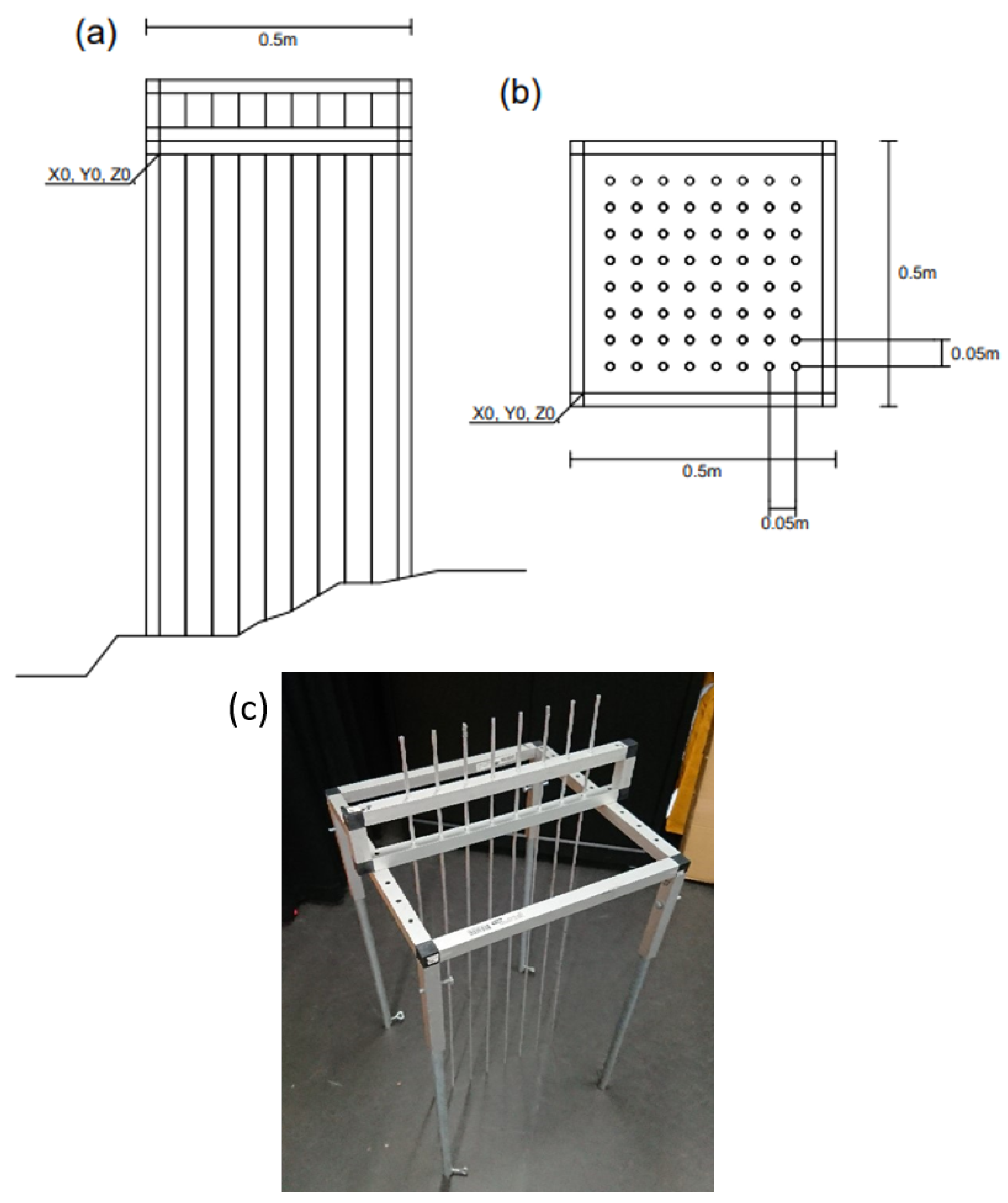
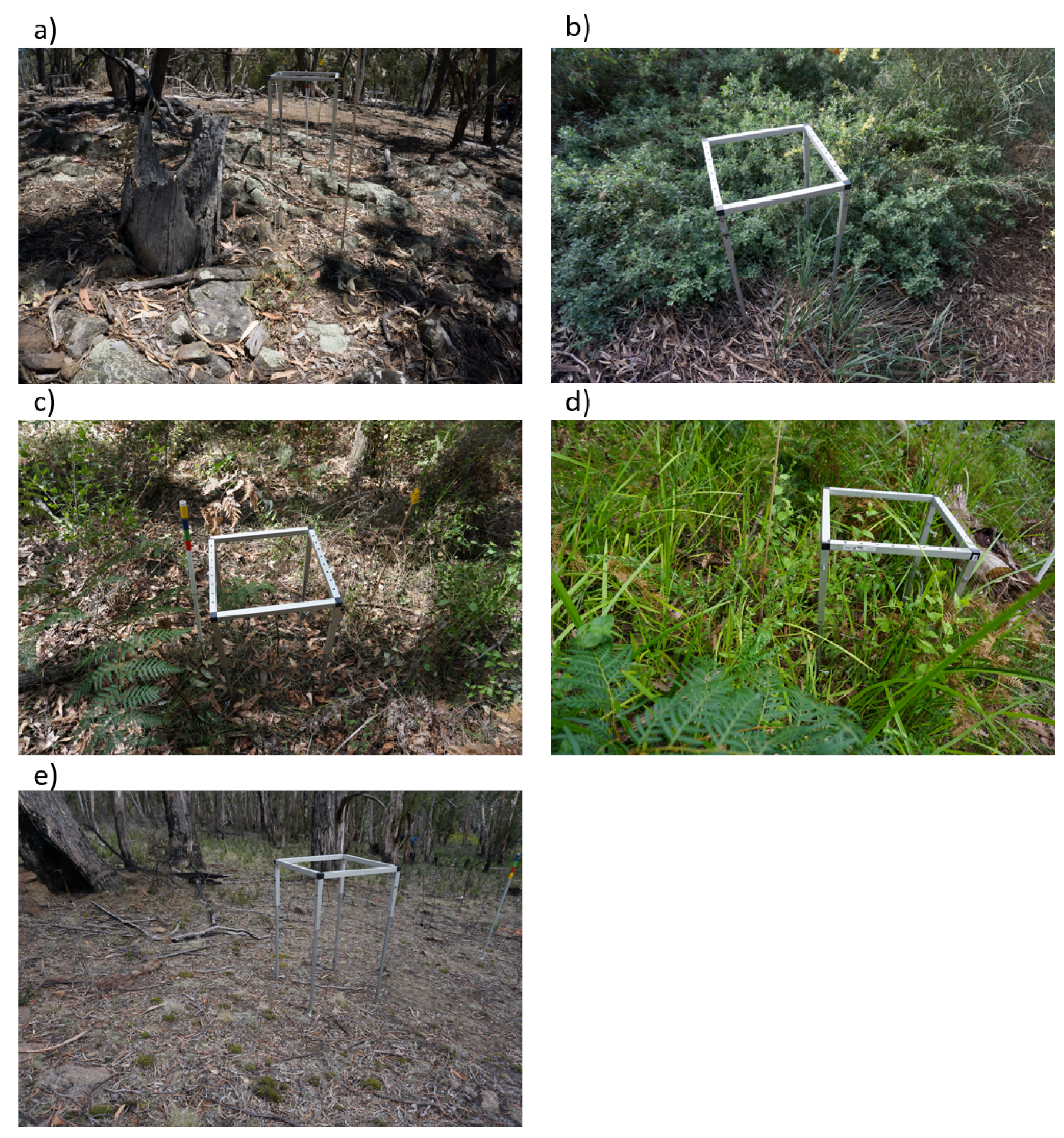

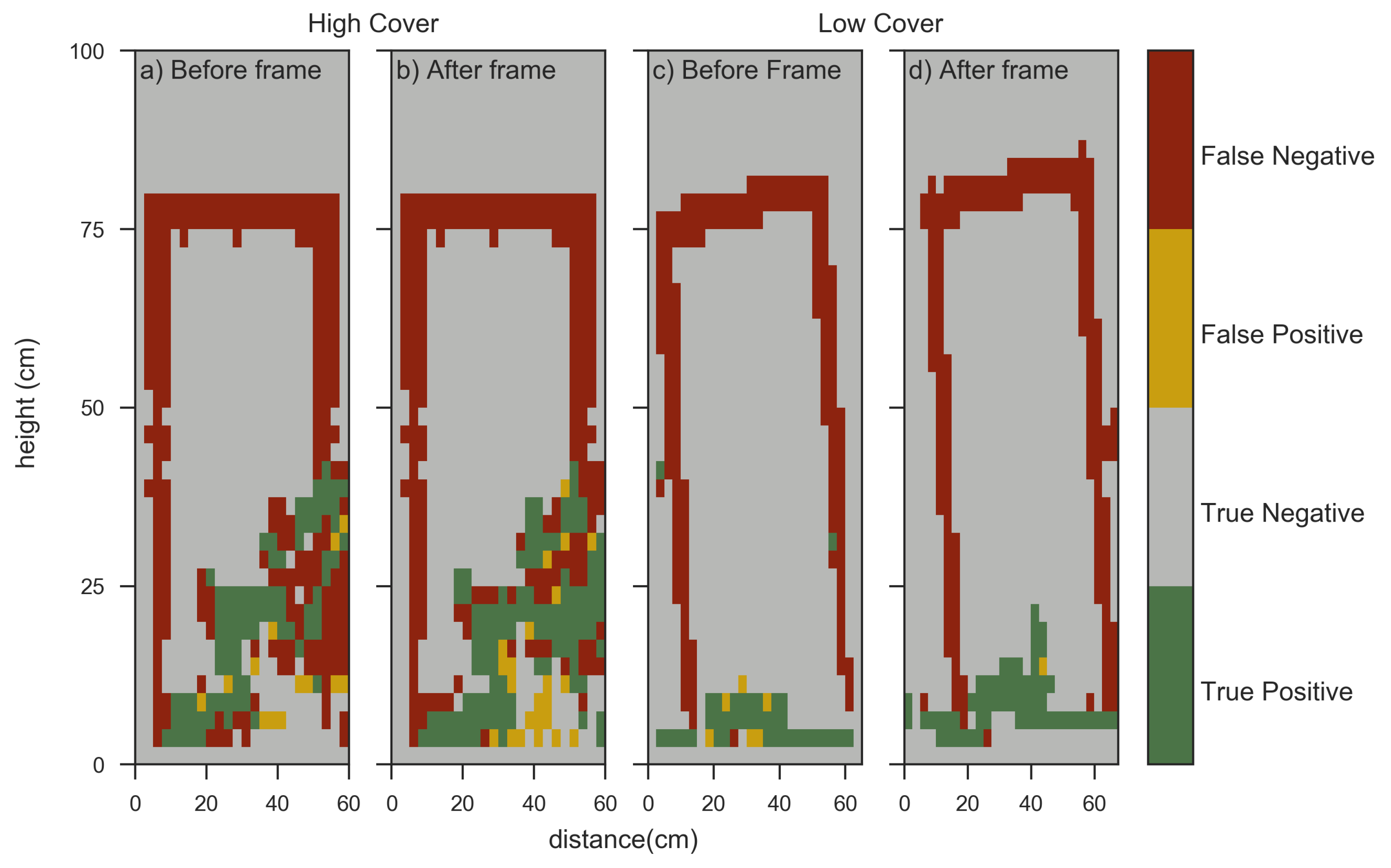
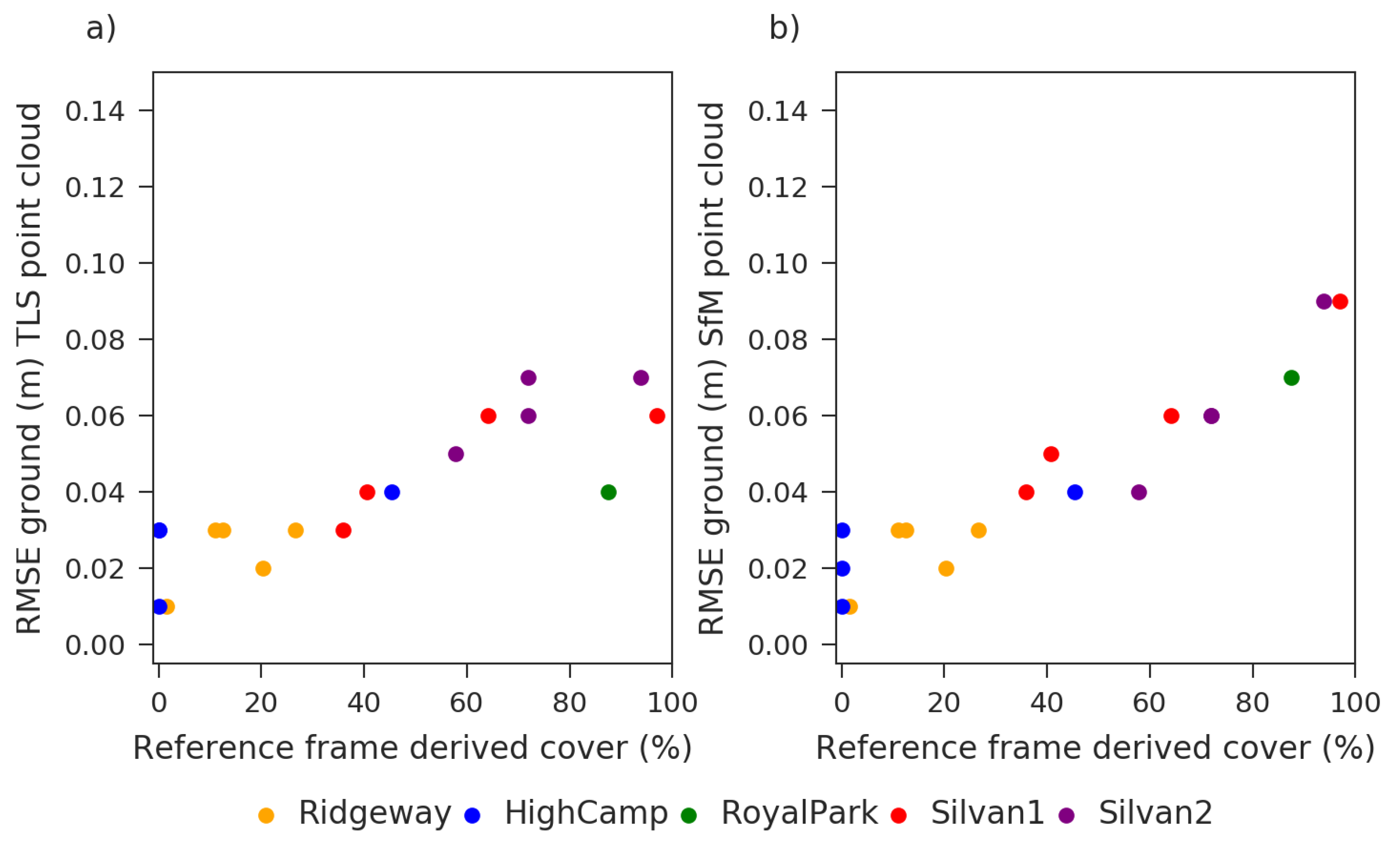
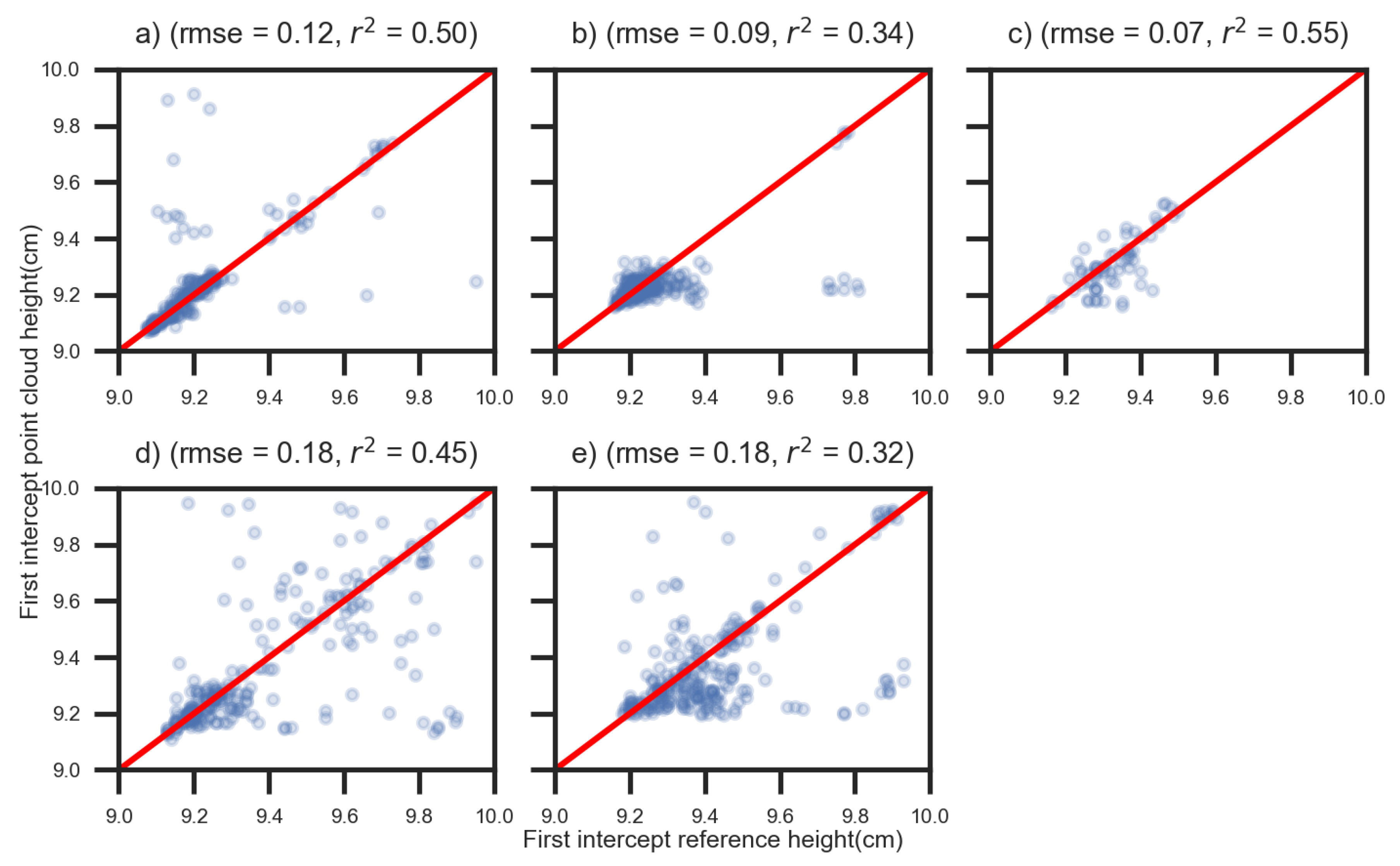
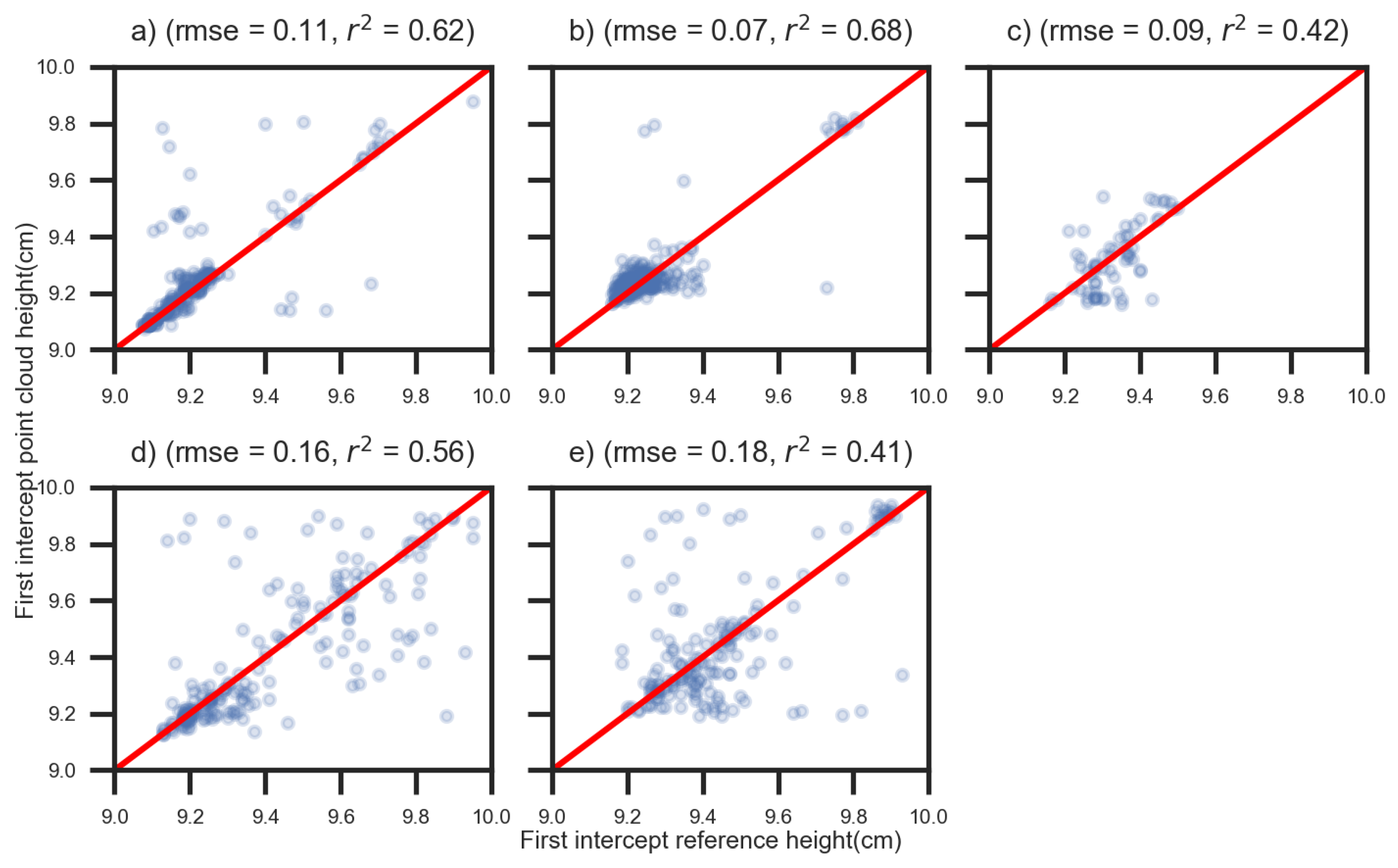
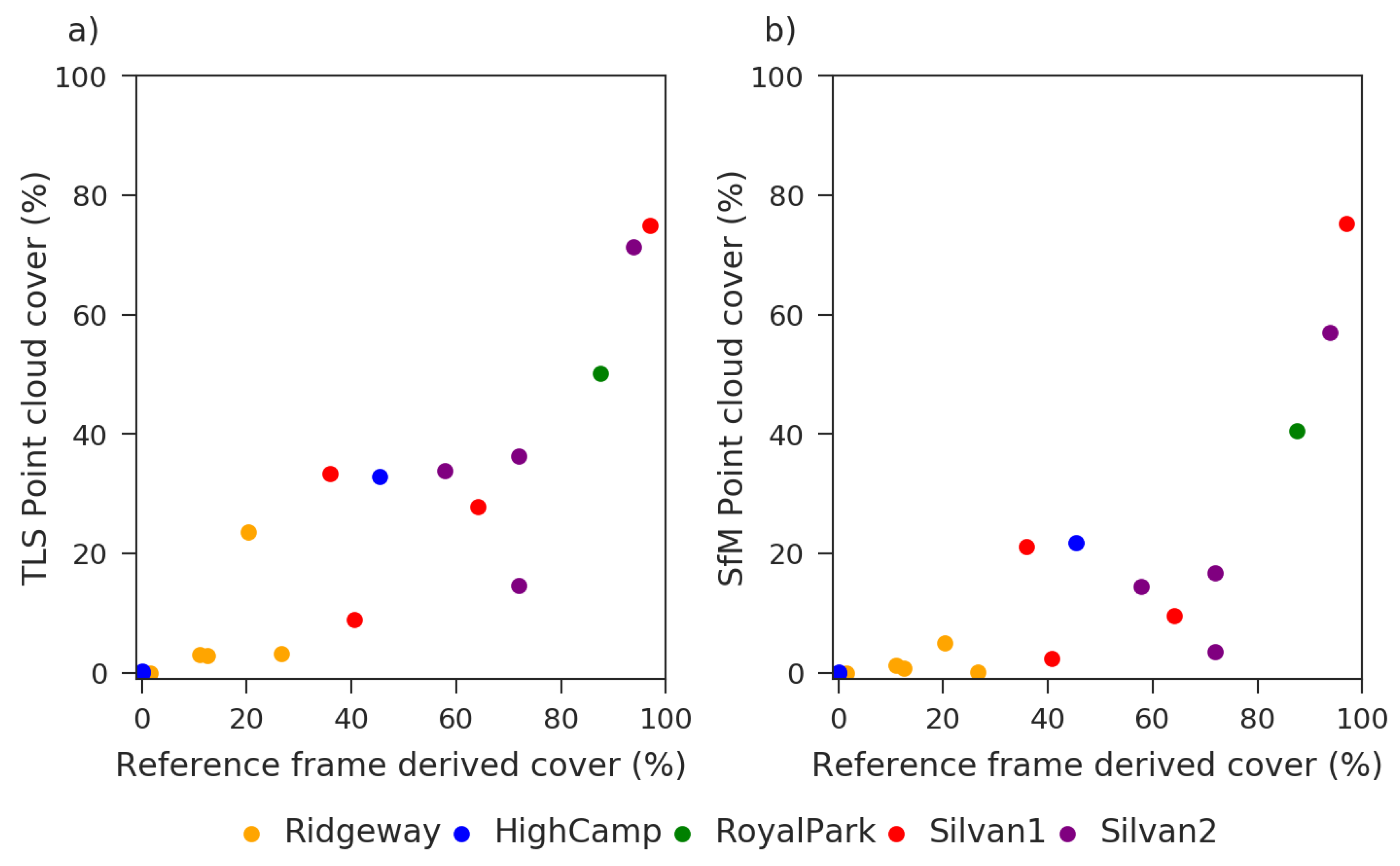

| Setting | SfM Value | TLS Value |
|---|---|---|
| Cloth Resolution (m) | 0.05 | 0.01 |
| Class Threshold (m) | 0.04 | 0.03 |
| Rigidity | 3 | 3 |
| Time Step | 0.50 | 0.20 |
| Iterations | 1000 | 1000 |
| Plot Name | TP (%) | TN (%) | FP (%) | FN (%) | MCC |
|---|---|---|---|---|---|
| High Camp | 333 (2.67) | 11,658 (93.41) | 311 (2.49) | 178 (1.43) | 0.56 |
| Royal Park | 237 (6.50) | 3053 (83.69) | 178 (4.88) | 180 (4.93) | 0.51 |
| Silvan1 | 568 (4.25) | 11,453 (85.62) | 531 (3.97) | 824 (6.16) | 0.40 |
| Silvan2 | 557 (3.27) | 15,148 (88.98) | 491 (2.88) | 828 (4.86) | 0.42 |
| Ridgeway | 575 (4.05) | 13,091 (92.14) | 307 (2.16) | 235 (1.65) | 0.66 |
| Plot Name | TP (%) | TN (%) | FP (%) | FN (%) | MCC |
|---|---|---|---|---|---|
| High Camp | 265 (0.98) | 25,856 (95.28) | 599 (2.21) | 416 (1.53) | 0.33 |
| Royal Park | 289 (5.02) | 4735 (82.20) | 371 (6.44) | 365 (6.34) | 0.37 |
| Silvan1 | 385 (1.20) | 29,380 (91.81) | 499 (1.56) | 1736 (5.43) | 0.25 |
| Silvan2 | 232 (0.44) | 49,759 (95.05) | 549 (1.05) | 1812 (3.46) | 0.16 |
| Ridgeway | 623 (1.59) | 37,190 (94.95) | 923 (2.36) | 432 (1.10) | 0.47 |
| Plot Name | TP (%) | TN (%) | FP (%) | FN (%) | MCC |
|---|---|---|---|---|---|
| High Camp | 41 (0.25) | 15,717 (96.67) | 116 (0.71) | 384 (2.36) | 0.15 |
| Royal Park | 217 (3.20) | 5955 (87.78) | 239 (3.52) | 373 (5.50) | 0.37 |
| Silvan1 | 423 (1.79) | 21,231 (89.66) | 584 (2.47) | 1442 (6.09) | 0.27 |
| Silvan2 | 337 (1.10) | 28,381 (92.77) | 423 (1.38) | 1451 (4.74) | 0.26 |
| Ridgeway | 84 (0.35) | 23,092 (96.34) | 142 (0.59) | 651 (2.72) | 0.19 |
| Plot Name | TP (%) | TN (%) | FP (%) | FN (%) | MCC |
|---|---|---|---|---|---|
| High Camp | 46 (0.50) | 8666 (94.63) | 133 (1.45) | 313 (3.42) | 0.16 |
| Royal Park | 185 (6.57) | 2239 (79.51) | 151 (5.36) | 241 (8.56) | 0.41 |
| Silvan1 | 261 (1.79) | 13,000 (89.09) | 241 (1.65) | 1090 (7.47) | 0.28 |
| Silvan2 | 163 (0.66) | 23,149 (93.46) | 251 (1.01) | 1205 (4.87) | 0.19 |
| Ridgeway | 236 (1.44) | 15,500 (94.70) | 236 (1.44) | 395 (2.41) | 0.41 |
© 2019 by the authors. Licensee MDPI, Basel, Switzerland. This article is an open access article distributed under the terms and conditions of the Creative Commons Attribution (CC BY) license (http://creativecommons.org/licenses/by/4.0/).
Share and Cite
Hillman, S.; Wallace, L.; Reinke, K.; Hally, B.; Jones, S.; Saldias, D.S. A Method for Validating the Structural Completeness of Understory Vegetation Models Captured with 3D Remote Sensing. Remote Sens. 2019, 11, 2118. https://doi.org/10.3390/rs11182118
Hillman S, Wallace L, Reinke K, Hally B, Jones S, Saldias DS. A Method for Validating the Structural Completeness of Understory Vegetation Models Captured with 3D Remote Sensing. Remote Sensing. 2019; 11(18):2118. https://doi.org/10.3390/rs11182118
Chicago/Turabian StyleHillman, Samuel, Luke Wallace, Karin Reinke, Bryan Hally, Simon Jones, and Daisy S. Saldias. 2019. "A Method for Validating the Structural Completeness of Understory Vegetation Models Captured with 3D Remote Sensing" Remote Sensing 11, no. 18: 2118. https://doi.org/10.3390/rs11182118
APA StyleHillman, S., Wallace, L., Reinke, K., Hally, B., Jones, S., & Saldias, D. S. (2019). A Method for Validating the Structural Completeness of Understory Vegetation Models Captured with 3D Remote Sensing. Remote Sensing, 11(18), 2118. https://doi.org/10.3390/rs11182118








